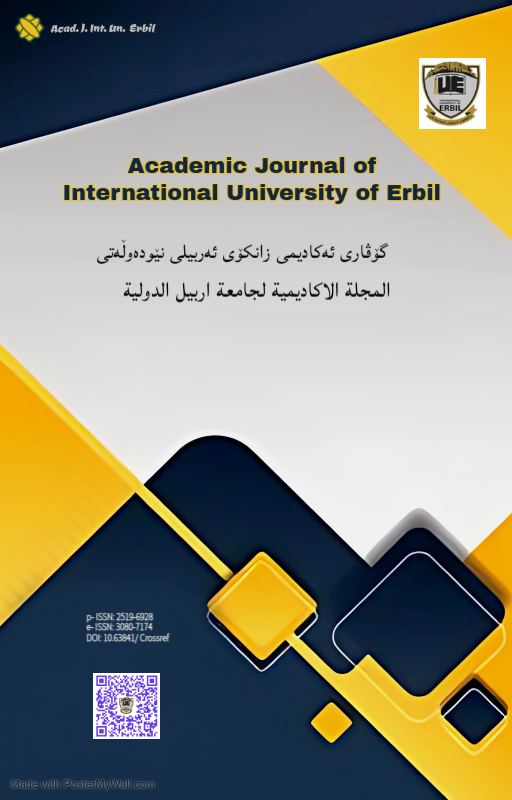Factors Affecting Investment in Cryptocurrencies Among University Students in Kurdistan: An Application of the Theory of Reasoned Action
DOI:
https://doi.org/10.63841/iue12436Keywords:
Attitudes, intentions to invest in cryptocurrency, perceived ease of use and usefulness perceived risk, subjective norm and trust.Abstract
This study investigates the factors influencing university students’ intentions to invest in cryptocurrency in the Kurdistan Region of Iraq. The target population for this research comprised 345 students enrolled in four private universities across the Kurdistan Region of Iraq. The collected findings were analysed using a structural equation modelling approach. The results reveal that perceived risk has a significant positive effect on both intentions to invest in cryptocurrency and attitudes towards cryptocurrency use. Perceived ease of use and usefulness also significantly impact. Subjective norms and trust significantly influence attitudes towards cryptocurrency use but their direct effect on intentions to invest in cryptocurrency is insignificant. Finally, attitudes towards cryptocurrency use have a significant direct impact on intentions to invest in cryptocurrency. The findings also demonstrate that university students’ attitudes toward cryptocurrency mediate the relationships between perceived risk, perceived ease of use, usefulness, subjective norms and trust, which underscores the importance of understanding how students form their attitudes towards cryptocurrencies. Educational institutions should implement robust financial literacy campaigns that emphasize both the potential benefits and significant risks of cryptocurrency investments. Cryptocurrency platforms should focus on clear and transparent communication of both the risks and benefits associated with cryptocurrency use.
References
Ahmed, A., & Wang, Q. (2021). Cryptocurrency Investment in Emerging Markets: Factors and Implications. Emerging Markets Finance and Trade, 57(9), 1452-1467.
Abdulkhaliq, S. S., Abdullah, D. F., & Yousif, M. S. (2024). The Role of Organizational Innovative Capabilities in Achieving Strategic Agility: An analytical study of the opinions of administrative leaders in private universities in the Kurdistan Region of Iraq. Twejer Journal, 7(1), 1272-1307.
Abdullah, N. N., & Othman, M. B. (2019). Examining the effects of intellectual capital on the performance of Malaysian food and beverage small and medium-sized enterprises. Technology (Ijciet), 10(2), 135-143.
Almajali, D. A., Masa’Deh, R. E., & Dahalin, Z. M. (2022). Factors influencing the adoption of Cryptocurrency in Jordan: An application of the extended TRA model. Cogent Social Sciences, 8(1), 2103901.
Alomari, A. S., & Abdullah, N. L. (2023). Factors influencing the behavioral intention to use Cryptocurrency among Saudi Arabian public university students: Moderating role of financial literacy. Cogent Business & Management, 10(1), 2178092.
Alqaryouti, O., Siyam, N., Alkashri, Z., & Shaalan, K. (2019, December). Cryptocurrency usage impact on perceived benefits and users’ behaviour. In European, Mediterranean, and Middle Eastern Conference on Information Systems (pp. 123-136). Cham: Springer International Publishing.
Avci, İ., Özmen, E., & Ozhan, M. (2023). ONLİNE ALIŞVERİŞTE KRİPTO PARA KULLANIMI İLE İLGİLİ TÜKETİCİ GÖRÜŞLERİNİN ARAŞTIRILMASI. International Journal of Management Economics and Business.
Byrne, B. M. (1994). Structural equation modeling with EQS and EQS/Windows. Thousand Oaks, CA: Sage Publications.
Cai, W., Lee, J., & Clark, L. (2019). Psychological factors influencing cryptocurrency investment: An analysis of risk tolerance and behavioral biases. Journal of Behavioral Finance, 20(3), 221-233.
Chang, Y., Wong, F. K., & Lee, H. Y. (2021). The role of subjective norms and trust in cryptocurrency adoption: A study among millennials. Technology in Society, 67, 101723.
Davis, F. D. (1989). Perceived usefulness, perceived ease of use, and user acceptance of information technology. MIS Quarterly, 13(3), 319-340.
dos Santos, P. M., & Cirillo, M. Â. (2023). Construction of the average variance extracted index for construct validation in structural equation models with adaptive regressions. Communications in Statistics-Simulation and Computation, 52(4), 1639-1650.
Efendioğlu, İ. H., Gökhan, A. K. E. L., Değirmenci, B., Aydoğdu, D., Elmasoğlu, K., Doyduk, H. B. B., ... & Bahçe, H. (2023). The Mediating Effect of Blockchain Technology on the Cryptocurrency Purchase Intention. Sosyal Bilimler Araştırma Dergisi, 12(13), 1536-1559.
Fishbein, M., & Ajzen, I. (1975). Belief, attitude, intention, and behavior: An introduction to theory and research. Addison-Wesley.
Hair, J. F., Hult, G. T. M., Ringle, C. M., & Sarstedt, M. (2019). A primer on partial least squares structural equation modeling (PLS-SEM) (2nd ed.). SAGE Publications.
Haji-Othman, Y., & Yusuff, M. S. S. (2022). Assessing reliability and validity of attitude construct using partial least squares structural equation modeling. Int J Acad Res Bus Soc Sci, 12(5), 378-385.
Hanafiah, M. H. (2020). Formative vs. reflective measurement model: Guidelines for structural equation modeling research. International Journal of Analysis and Applications, 18(5), 876-889.
Henseler, J., Ringle, C. M., & Sarstedt, M. (2015). A New Criterion for Assessing Discriminant Validity in Variance-based Structural Equation Modeling., Journal of the Academy of Marketing Science, 43(1): 115-135.
Kahneman, D., & Tversky, A. (1979). Prospect theory: An analysis of decision under risk. Econometrica, 47(2), 263-291.
Khorsheed, R. K., Abdulla, D. F., Othman, B. A., Mohammed, H. O., & Sadq, Z. M. (2020). The Role of Services Marketing Mix 7P's on Achieving Competitive Advantages (The Case of Paitaxt Technical Institute in Kurdistan Region of Iraq). TEST Engineering and Management, 83, 15947-15971.
Kim, D. J., Chan, H. C., & Gupta, S. (2016). Value-based adoption of mobile banking services: An empirical investigation. Journal of Enterprise Information Management, 29(2), 287-308.
Kim, D., Kim, J., & Lee, S. (2016). Exploring the determinants of cryptocurrency investment behavior using the technology acceptance model. Journal of Financial Technology, 12(2), 85-102.
Kim, J., Park, S., & Choi, D. (2016). Investigating the factors influencing cryptocurrency investment using the Technology Acceptance Model (TAM). Journal of Information Technology, 31(4), 354-372.
Kim, Y. H., & Song, J. M. (2020). Trust and risk in cryptocurrency investment: The mediating role of attitudes. Journal of Financial Services Marketing, 25(4), 309-320.
Krejcie, R. V., & Morgan, D. W. (1970). Determining sample size for research activities. Educational and Psychological Measurement, 30(3), 607-610.
Kumar, N., & Yadav, V. (2021). Financial literacy and cryptocurrency investments: An emerging market perspective. Emerging Markets Review, 50, 101657.
Lee, C. S., Cho, Y. K., & Hwang, J. (2020). Demographic factors influencing cryptocurrency investment intentions. Journal of Financial Planning, 33(5), 62-72.
Lee, J. H., & Kim, S. H. (2020). Demographic factors and their effects on cryptocurrency investment behavior: Evidence from South Korea. Journal of Financial Research, 43(1), 87-104.
Lee, K., Chang, H., & Moon, J. (2020). Demographic factors as predictors of cryptocurrency investment: A study of age, income, and education. Journal of Economics and Business Research, 25(3), 230-245.
Mohammed, H. O., Abdullah, N. N., Majeed, H. L., & Sadq, Z. M. (2022). The Role of Strategic Leadership in Organizational Learning: A theoretical perspective. Qalaai Zanist Journal, 7(3), 1081-1095.
Nadeem, M. A., Liu, Z., Pitafi, A. H., Younis, A., & Xu, Y. (2021). Investigating the adoption factors of cryptocurrencies—a case of bitcoin: empirical evidence from China. SAGE open, 11(1), 2158244021998704.
Namahoot, K. S., & Rattanawiboonsom, V. (2022). Integration of TAM model of consumers’ intention to adopt cryptocurrency platform in Thailand: the mediating role of attitude and perceived risk. Human Behavior and Emerging Technologies, 2022(1), 9642998.
Nasir, M., & Aziz, M. (2021). Behavioral biases and cryptocurrency investment decisions: The impact of overconfidence and loss aversion. Journal of Behavioral Economics and Finance, 29(2), 101-115.
Nguyen, T. T., Luong, D., & Tran, M. T. (2021). Factors influencing cryptocurrency investment behavior: An empirical study. Finance Research Letters, 38, 101646.
Nurmawan, A., Putri, R. D., & Rupaidah, E. (2023). Analysis of Student Perceptions About Cryptocurrency Assets Viewed from Perceived Costs, Benefits and Risks. Economic Education and Entrepreneurship Journal, 6(1), 110-117.
Paat, R. E. F., Kindangen, P., & Rumokoy, L. J. (2023). Cryptocurrency: Do Knowledge And Emotion Impact Investment Intention?(Study On Young Adults In Manado). Jurnal EMBA: Jurnal Riset Ekonomi, Manajemen, Bisnis dan Akuntansi, 11(3), 323-335.
Riley, J. (2021). The current status of cryptocurrency regulation in China and its effect around the world. China and WTO Review, 7(1), 135-152.
Schumacker, R. E., and Lomax, R. G. (2004). A beginner’s guide to structural equation modeling, Second edition. Mahwah, NJ: Lawrence Erlbaum Associates.
Senkardes, C. G., & Akadur, O. (2021). A research on the factors affecting cryptocurrency investments within the gender context. Journal of business economics and Finance, 10(4), 178-189.
Shrestha, N. (2020). Detecting multicollinearity in regression analysis. American Journal of Applied Mathematics and Statistics, 8(2), 39-42.
Wen, Z., Yang, Q., & Zhang, H. (2019). Accounting practices and financial performance: The moderating role of perceived economic risk in uncertain environments. Journal of Corporate Finance, 57, 206-220.
Xi, D., O’Brien, T. I., & Irannezhad, E. (2019). Investigating the investment behaviours in cryptocurrency. arXiv preprint arXiv:1912.03311.
Yen, C., Tsai, C., & Lin, F. (2018). The impact of financial literacy on cryptocurrency investment decisions: A behavioral perspective. International Journal of Finance and Economics, 23(2), 241-257.
Yen, H. R., & Lee, C. F. (2018). Factors influencing the adoption of cryptocurrency investment: A study of financial literacy and its implications. International Journal of Finance & Economics, 23(3), 245-261.
Yen, T., Chiang, Y., & Huang, C. (2018). The role of financial literacy in cryptocurrency investment decisions: An empirical study. International Journal of Economics and Finance, 10(6), 112-123.
Yuen, K. F., & Kwok, S. Y. (2021). The effect of social influence and perceived risk on cryptocurrency adoption: Evidence from university students. Journal of Behavioral and Experimental Finance, 30, 100497.
Zhang, L., & Chen, X. (2021). The Role of Social Media Sentiment in Cryptocurrency Investment Decisions." International Review of Financial Analysis, 77, 101-116.
Downloads
Published
Issue
Section
License
Copyright (c) 2024 Academic Journal of International University of Erbil

This work is licensed under a Creative Commons Attribution 4.0 International License.













